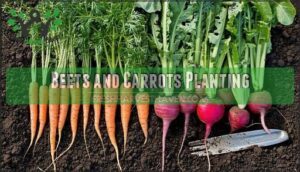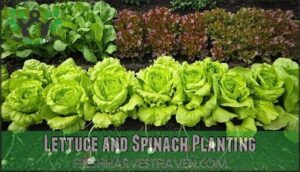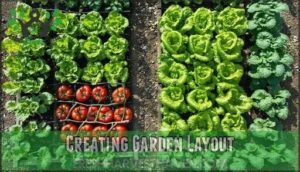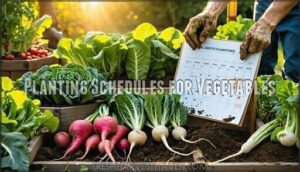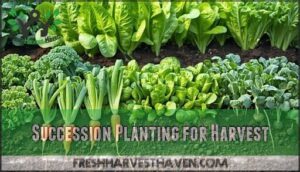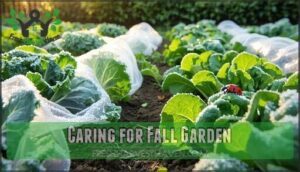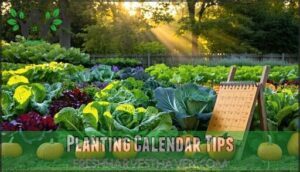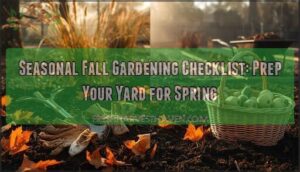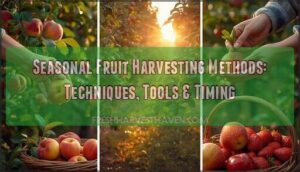This site is supported by our readers. We may earn a commission, at no cost to you, if you purchase through links.
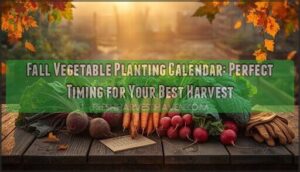
Count backwards from that date to determine when to plant cool-season crops. Beets, carrots, and radishes need 8-10 weeks before frost, while lettuce and spinach can handle just 6-8 weeks.
Broccoli and kale transplants go in 10-12 weeks early. Don’t forget garlic—it’s planted in fall for next summer’s harvest.
Think of fall planting as nature’s second chance at gardening glory. The cooler weather actually makes many vegetables sweeter and more flavorful than their spring counterparts, making it a great opportunity for gardening glory.
Table Of Contents
- Key Takeaways
- Fall Planting Basics
- Cool Season Crops
- Fall Garden Planning
- Caring for Fall Garden
- Planting Calendar Tips
- Frequently Asked Questions (FAQs)
- When should I start my fall vegetable garden?
- What fall vegetables can be planted now?
- What vegetables can and cannot be planted next to each other?
- What is the best vegetable to grow in the fall?
- Is September too late to plant fall vegetables?
- What vegetables are best to plant in the fall?
- What vegetables to plant in what month?
- What vegetable grows best in the fall?
- What vegetables can be planted in October?
- What vegetables can you plant in the fall?
- Conclusion
Key Takeaways
- Know your first frost date and count backward 6-12 weeks to determine when you’ll plant each crop—this becomes your planting roadmap for perfect timing.
- Plant cool-season crops like lettuce, spinach, kale, carrots, and beets during late summer since they’ll actually taste sweeter after light frosts touch them.
- Use row covers and proper mulching techniques to extend your growing season weeks beyond normal frost dates, keeping fresh vegetables coming well into winter.
- Create succession plantings every 2-3 weeks with the same crops to maintain continuous harvests rather than getting everything ready at once.
Fall Planting Basics
Fall gardening starts with knowing your first frost date—this simple number becomes your planting roadmap for timing everything perfectly.
You’ll want to count backward from that date, add extra time for slower fall growth, and choose crops that thrive in cooler weather.
Determining First Frost Dates
Everyone’s frost timeline differs, making Frost Date Averages your starting point, not your final answer.
You’ll find Historical Data through NOAA’s zip code lookup more accurate than basic Zone Hardiness maps.
Microclimate Impact matters—your yard’s elevation, nearby water, or urban heat can shift dates by weeks.
Predictive Models help, but check both first frost and hard freeze predictions.
Protecting plants with a frost protection product can extend the growing season.
Smart gardeners use conservative estimates for their planting calendar success.
Choosing Right Crops for Region
Once you know your first frost date, selecting the right cool season crops for your area becomes your next smart move.
Your hardiness zones and regional microclimates determine which vegetable varieties will thrive in your fall vegetable planting calendar.
Frost tolerant vegetables like kale and spinach work great in northern zones, while southern gardeners can grow heat-resistant lettuce longer.
Consider climate considerations, soil suitability, and local pests when choosing varieties.
Your planting zones guide tells you exactly which crops match your conditions perfectly.
Preparing Soil for Fall
Success after summer’s heat requires smart soil preparation. After heavy-feeding crops deplete nutrients, mix compost and organic fertilizer into your beds.
Add organic nitrogen if tomatoes or squash grew there previously. Soil temperature above 60°F helps fall seeds germinate quickly.
Compost amendments restore pH balance between 6.0-7.0 for ideal growth. Many gardeners find that compost improves soil structure substantially.
Apply mulch after planting for moisture retention and temperature control. Cover cropping between plantings suppresses weeds while building soil structure for your fall vegetable planting calendar.
Cool Season Crops
Cool-season crops thrive in fall’s cooler temperatures and actually taste sweeter after a light frost touches them.
You’ll want to time your planting just right—these vegetables need enough warm days to establish before winter arrives, but they’ll reward you with tender, flavorful harvests well into the colder months.
Beets and Carrots Planting
Beets and carrots are your fall garden’s dynamic duo.
Plant these root vegetables 8-10 weeks before your first frost date.
Sow beet varieties like ‘Detroit Dark Red’ and carrots 1/2 inch deep with proper carrot spacing of 2-3 inches apart.
Check soil pH stays between 6.0-7.0 for ideal growth.
Companion planting with onions helps deter pests.
Many gardeners find success using different beet seed varieties for staggered harvests.
Perfect harvest timing arrives in 50-80 days when roots reach ideal size.
Broccoli and Kale Planting
Timing makes all the difference when growing these cold-weather champions. Plant broccoli and kale 85-100 days before your first frost date, typically mid-July through early August in northern zones.
These brassicas actually taste sweeter after experiencing light frosts, making fall planting ideal. Start seeds indoors 4-6 weeks before transplanting, or direct sow in prepared beds.
Space broccoli 18-24 inches apart and kale 12-18 inches apart for proper air circulation.
- Choose heat-tolerant broccoli varieties like ‘De Cicco’ or ‘Calabrese’ for fall success
- Select kale cultivars such as ‘Winterbor’ or ‘Redbor’ that handle temperature drops
- Practice companion planting with marigolds or nasturtiums for natural pest control
- Maintain consistent moisture with 1-1.5 inches of water weekly
- Use row covers when temperatures drop below 26°F for extended fall harvest
These nutrient-packed brassicas reward patient gardeners with months of fresh greens. You can also enrich the soil by adding compost or manure before planting.
Lettuce and Spinach Planting
Despite cool weather advantages, lettuce and spinach need careful timing to prevent bolting.
Plant these greens when soil drops below 75°F for maximum germination rates.
| Variety | Planting Window |
|---|---|
| Buttercrunch lettuce | August 15-September 10 |
| Bloomsdale spinach | August 20-September 5 |
| Oak leaf lettuce | September 1-15 |
| Space spinach | August 25-September 10 |
| Mesclun mix | September 1-20 |
Your fall vegetables thrive with companion planting—try pairing spinach with radishes.
This planting calendar guarantees tender harvests before winter arrives.
Fall Garden Planning
Planning your fall garden takes some strategic thinking, but it’s easier than juggling summer weeds and watering schedules.
You’ll want to map out your space, create planting schedules that work backward from frost dates, and set up succession plantings to keep fresh vegetables coming until winter arrives.
This process involves understanding the importance of succession plantings in maintaining a continuous supply of fresh produce throughout the seasons.
Creating Garden Layout
Your garden layout sets the foundation for harvest success. Map out your garden space like you’re planning a neighborhood—each plant needs the right spot to thrive.
Sunlight Mapping reveals your garden’s best real estate. Measure which areas get 6+ hours of direct sun daily. Space Optimization means grouping plants by their water and care needs.
Here’s your planning checklist:
- Position tall plants north to prevent shading shorter crops
- Design Aisle Widths of 18-24 inches for easy harvesting access
- Plan Companion Planting pairs like lettuce with radishes
- Consider Vertical Gardening for climbing peas and beans
Planting Schedules for Vegetables
Perfect timing starts with knowing your region’s first frost date and counting backward using each crop’s maturity timeline. Your fall planting guide becomes your roadmap to success.
| Crop Type | Planting Window |
|---|---|
| Leafy Greens | 6-8 weeks before frost |
| Root Vegetables | 8-10 weeks before frost |
| Brassicas | 6-8 weeks before frost |
| Quick Crops | 3-4 weeks before frost |
Staggered planting every two weeks extends your harvest window. Regional calendars provide baseline dates, but microclimate adjustments matter—urban areas stay warmer longer.
Check seed packets for maturity dates and add extra time for fall’s slower growth. Crop rotation keeps soil healthy between plantings. Your vegetable planting schedule transforms timing guesswork into autumn garden planning precision.
Succession Planting for Harvest
Why settle for a single harvest when you can keep the produce flowing? Succession planting transforms your fall garden into a continuous harvest machine that extends your growing season well beyond expectations.
Here’s your step-by-step planting schedule:
- Start fast growers early – Sow radishes and lettuce every 10-14 days through August
- Stagger planting dates – Plant the same crop variety 2-3 times with week intervals
- Mix maturity dates – Choose early, mid, and late-season varieties to maximize yield
- Rotate locations – Move crops to different beds each planting to reduce pest pressure
- Time final sowings – Calculate backward from first frost date, adding fall factor weeks
This staggered planting approach keeps your table loaded with fresh fall harvest vegetables while your neighbors wonder how you manage such abundance. Remember to keep in mind your first frost date for ideal planning.
Caring for Fall Garden
Once your fall vegetables are established, proper care guarantees they’ll thrive despite cooler weather and shorter days.
You’ll need to adjust your watering schedule, protect plants from pests, and prepare for frost to maximize your harvest through winter.
Watering and Mulching Techniques
Success breeds confidence in fall watering and mulching. Check soil moisture 1-2 inches deep before watering—your seedlings need consistent hydration, not drowning.
Apply water early morning for best absorption.
| Mulch Type | Benefits | Best For |
|---|---|---|
| Straw | Excellent insulation, easy removal | Root vegetables |
| Shredded leaves | Natural breakdown, weed suppression | Leafy greens |
| Grass clippings | Quick moisture retention | Quick-growing crops |
Spread 2-3 inches of garden mulch around plants for temperature regulation and moisture retention. This simple step transforms fall garden maintenance from daily worry to weekly check-ins, giving you more time to enjoy your thriving harvest.
Managing Pests and Diseases
After watering and mulching your fall crops, you’ll need to tackle the seasonal pest challenges that come with cooler weather.
While pest monitoring shows fewer issues than summer, fall vegetable gardening still faces specific threats like slugs thriving in moist conditions and lingering cabbage worms. Effective fall garden sanitation can reduce these issues.
Smart disease prevention and pest control protect your harvest:
- Fall sanitation – Remove plant debris weekly since fungal diseases love damp fall conditions
- Slug control – Use beer traps or diatomaceous earth around vulnerable lettuce and spinach
- Row covers – Deploy them for dual protection against both pests and temperature drops
Effective disease management means staying ahead of problems before they devastate your crops.
Using Row Covers for Frost
Most seasoned gardeners know that row covers are your secret weapon for extending harvest well beyond frost dates.
These protective barriers create a cozy microclimate that shields your cold-hardy vegetables from harsh weather while maintaining pest control benefits.
Choose the right row cover material based on your frost protection level needs.
Lightweight fabrics offer basic protection, while heavy insulating covers can guard against deeper freezes.
Install them properly using hoops to prevent direct contact with plants.
The installation technique varies depending on the type of row cover and the level of frost protection required.
Remember to ventilate during warm days to prevent overheating your fall vegetable gardening efforts.
Planting Calendar Tips
Creating a successful fall garden depends on understanding your local climate and frost patterns.
You’ll get the best results when you adjust your planting schedule to match your region’s unique growing conditions and use season-extending techniques to maximize your harvest window, which is crucial for a successful fall garden.
Adjusting for Regional Climate
Master your fall vegetable planting by understanding regional variations that make or break your harvest. Zone hardiness determines when you’ll plant—Zone 3 gardeners start in July while Zone 9 folks wait until late September.
Microclimate advantages like urban heat islands can extend your planting window by two weeks. Succession planting helps guarantee continuous harvests throughout the season.
- Urban areas stay 5-10°F warmer, giving you bonus planting time
- Coastal climate considerations moderate frost dates for longer growing seasons
- Localized calendars from extension services beat generic advice every time
Your backyard’s unique conditions trump broad frost tolerance guidelines.
Understanding Frost Dates
Every gardener’s fall planting timeline hinges on their area’s frost dates—think of them as your garden’s expiration date. Predicting frost isn’t guesswork; check historical data for your zone.
Microclimate influence matters too—urban heat islands delay frost while low-lying areas freeze first. Zone hardiness determines your risk level, with northern zones facing frost date impact earlier.
Smart fall gardening means knowing these patterns shape your planting calendar success.
Extending Growing Season With Covers
You don’t have to let frost dates dictate your fall garden schedule.
Row covers and cold frames become your secret weapons for season extension, pushing your harvest weeks beyond normal limits.
These cover types provide frost protection and heat retention while offering bonus pest exclusion.
Choose materials that balance protection with proper light transmission.
With smart covering strategies, you’ll keep extending growing season possibilities alive when Mother Nature tries calling it quits.
Frequently Asked Questions (FAQs)
When should I start my fall vegetable garden?
You should start planting fall vegetables 8-12 weeks before your area’s first expected frost date.
Count backward from that date, add extra time for slower fall growth, and you’ll have your perfect planting window.
What fall vegetables can be planted now?
Don’t think you’ve missed the boat—fall planting season’s just getting started! Now you can plant lettuce, spinach, kale, radishes, carrots, and beets for fresh autumn harvests.
What vegetables can and cannot be planted next to each other?
Companion planting matters! You’ll want to pair tomatoes with basil, carrots with onions, and lettuce with radishes.
Avoid planting beans near onions, carrots near dill, or brassicas together—they’ll compete fiercely for nutrients.
What is the best vegetable to grow in the fall?
Lettuce’s absolutely your golden ticket for fall gardening success! You’ll get crisp, sweet leaves in just 30-45 days, thriving in cool weather while dodging summer’s brutal heat and pests.
Is September too late to plant fall vegetables?
September isn’t too late for fall vegetables! You can still plant fast-growing greens like lettuce, spinach, and arugula. They’ll thrive in cooler weather and be ready before frost hits.
What vegetables are best to plant in the fall?
Cool-season crops thrive in fall’s perfect conditions. Plant leafy greens like lettuce, spinach, and kale, plus root vegetables like carrots, beets, and radishes for sweet, tender harvests.
What vegetables to plant in what month?
You’ll want to time your planting based on your first frost date.
August through September work best for most fall vegetables, with leafy greens planted six to eight weeks before frost arrives in your area.
What vegetable grows best in the fall?
Leafy greens like spinach, kale, and lettuce thrive in fall’s cooler temperatures. You’ll get sweeter flavors and fewer pest problems compared to summer growing.
What vegetables can be planted in October?
As autumn’s golden tapestry unfolds, you can still plant fast-growing greens like arugula, spinach, and lettuce in October. Choose quick-maturing varieties that’ll beat winter’s first freeze to your table.
What vegetables can you plant in the fall?
Plant lettuce, spinach, kale, radishes, carrots, and beets 6-10 weeks before your first frost.
These cool-weather crops thrive in fall’s warm soil and cooler air, giving you fresh harvests when summer gardens fade.
Conclusion
Success blooms like a well-tended garden when you follow your fall vegetable planting calendar carefully.
You’ve learned the timing secrets that transform ordinary plots into abundant harvests.
Your frost dates guide every planting decision, while cool-season crops reward your patience with exceptional flavor.
Remember, fall gardening isn’t just about surviving winter—it’s about thriving through it.
With proper planning and seasonal awareness, you’ll enjoy fresh vegetables long after summer gardens fade away completely.
- https://extension.uga.edu/publications/detail.html?number=C943&title=vegetable-garden-calendar
- https://www.almanac.com/gardening/planting-calendar
- https://wayne.ces.ncsu.edu/2022/08/time-to-plant-a-fall-vegetable-garden/
- https://freshexchange.com/fall-vegetable-garden-plant-guide/
- https://extension.umd.edu/resource/vegetable-planting-calendar

